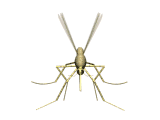 Mosquito Repellents - February 2, 2005 Jeff Schalau, County Director, Agent, Agriculture & Natural Resources Arizona Cooperative Extension, Yavapai County In 2004, Arizona had 391 human cases (including 14 deaths) of West Nile Virus (WNV). While most cases of WNV were reported in lower elevation areas (primarily in the greater Phoenix area), one case was reported in the Verde Valley. Since we are experiencing above average precipitation thus far in 2005, it is imperative that Arizona residents take steps and prepare for mosquitoes and WNV as temperatures warm this spring. While I wrote about general precautions that residents should take in the September 3, 2003 Backyard Gardener column (available on the web site listed below), I recently found some new information regarding mosquito repellents. The following information was excerpted from Common Sense Pest Control Quarterly, Vol XX, No. 2, Spring 2004 and is backed by peer-reviewed medical studies and entomological research. Most agencies that are coping with WNV issues have recommended deet (a widely used active ingredient in many mosquito repellents). Deet is highly effective at repelling mosquitoes and the acute toxicity (risk associated with occasional use) is low. Nevertheless, when applied directly to the skin, about 9-56% is absorbed through the skin and 17% into the blood. Only about one-half of this is excreted over a five-day period. People applying deet to their skin on a daily basis could be exposed to up to one pound of active ingredient over a six-month period. This is considered chronic exposure and can result in dermatitis, allergy, and neurotoxic effects. Symptoms of muscle cramping, confusion, insomnia, depression, and irritability have been reported. In addition, deet is not recommended for children under two years of age. To reduce exposure, deet can be applied to clothing rather than the skin. When absorbed in cotton, it can effectively repel mosquitoes for several weeks. Some species of mosquitoes prefer to feed on lower body parts, so treating socks or anklets can also be an effective use of deet. These strategies can significantly reduce the user’s exposure to deet. Of course, you must weigh these potential risks against the risk of infection with WNV. Avon Skin-So-Soft, a skin cream product, is also an effective repellent for certain mosquito species. Though less effective than deet, its active ingredients are dimethyl phthalate (DMP), vanillin, coumarin, and piperonal. DMP was patented as a mosquito repellent in 1929 and was used in various formulations prior to the introduction of deet in 1955. Botanical compounds (extracts from plant materials) have also been used as personal mosquito repellents. Citronella oil has been used as a mosquito repellent for over 50 years and is not expected to pose health risks to people, including children and other sensitive populations. Other compounds also show promise as skin-applied mosquito repellents. These include extracts from garlic, basil, neem, catnip, birch, bluestem grass, rosemary, spearmint, peppermint, cinnamon, and many others. Some of these products are available for purchase, but use caution. They may not have undergone the extensive testing required for EPA Registration required to be labeled as a pesticide. Just because a compound comes from a “natural” source, it does mean that it is safe for human use. Many plants are highly toxic (e.g. oleander, hemlock, ect.). William Quarles, the author of the Common Sense Pest Control Quarterly article referenced above sees great potential in the development of botanical mosquito repellents. These products would also be more affordable to people living in lesser developed countries therefore giving them an added advantage where many other diseases are transmitted by mosquitoes. Much work is still needed to adequately screen these botanical sources to isolate the specific compounds that repel mosquitoes and assess the risks related to human exposure. Naming of companies or products is neither meant to imply endorsement by the author nor criticism of similar companies or products not mentioned. The University of Arizona Cooperative Extension has publications and information on gardening and pest management. If you have other gardening questions, call the Master Gardener line in the Cottonwood office at 646-9113 ext. 14 or E-mail us at mgardener@verdeonline.com and be sure to include your address and phone number. Find past Backyard Gardener columns or submit column ideas at the Backyard Gardener web site: http://cals.arizona.edu/yavapai/anr/hort/byg/. |